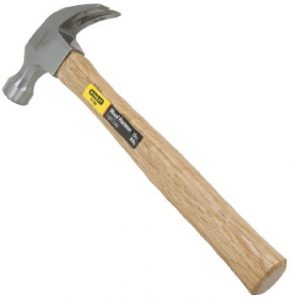For some reason, I have always liked framing hammers with wooden handles. Always felt far more comfortable in my hand than composites or steel handles.
Hickory handles beat synthetic materials for strength, and also have the benefit of less vibration. Wood transfers less vibration than metal.
Some hammers have a fiberglass shaft core or a glass filled nylon and a thermoplastic rubber over molded handle, all of which have been designed to reduce vibration. Proponents of synthetic handles argue wood loses its vibration dampening over time.
Many carpenters have gone to steel shanks because over time their wood handle hammers loosen at the head. This is because vibration traveling thru the handle degrades the bond between the handle and head.
 Wood handles are kiln dried and then turned at an optimal moisture content of 10-12%, over course of time the wood dries out even more and the handle loosens.
Wood handles are kiln dried and then turned at an optimal moisture content of 10-12%, over course of time the wood dries out even more and the handle loosens.
If you are old school and you appreciate a wood handle, like me, then here’s a few tips to keep your hammer working well:
Look for a hammer handle which uses radial wedges to hold the hammer head onto the Hickory handle. Flat barbed wedges were the old standard but they tend to loosen over time.
Some manufacturers use flat wedges to hold the handle to the head. Flat wedges only compress side to side and we’ve seen many manufactures adding two wedges, set at an angle to offset this issue.
Radial wedges are a better way to attach a hammer head to a handle. The radial wedges force the material bi-laterally, in every direction resulting in less loosening forward and aft. The end result is a longer hammer service life
Now the tip for the wood handled hammer you already own:
Old time carpenters (I suppose this now makes me old time?) used to soak their hammer head in water to swell the wood and tighten it to the head.
The better way to do this is to use mineral oil. Mineral oil is soaked into the wood capillaries in the handle and maintains moisture in the wood. To do this, simply set your hammer upside down in mineral oil and the wood fiber will swell, tightening the head bond. Your hammer will last longer.
Happy hammering!






